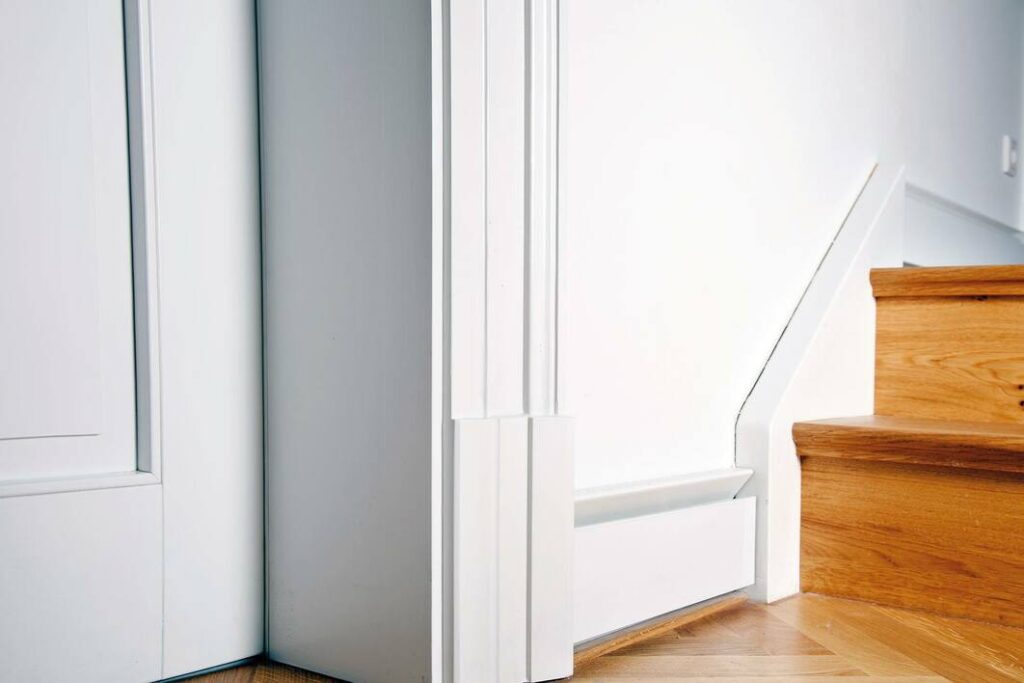Baseboard heating
With conventional radiators, you pay at least 20 % too much for heating because a large part of the heat accumulates unused under the ceiling. Heat your rooms evenly with baseboard heating and stop paying too much.

Homepage › Baseboard heating
Baseboard heaters
Skirting heating is an elongated radiator in the shape of a skirting board that runs along the entire length of the wall. Similar to conventional radiators, warm air rises from the baseboard heater. However, this does not heat the room air, but only the surfaces of the walls.
The heated wall surfaces then radiate heat into the room like a tiled stove, heating the room evenly. This saves up to 30 % in heating costs, because a large proportion of the heat does not accumulate unused under the ceiling. The energy used only has to heat the wall surface - not the entire room air volume.
Apart from lower heating costs, baseboard heating is an energy-efficient, environmentally friendly heating system that ensures a healthy indoor climate. It also provides pleasant, even heat at critical points such as the floor-wall connection. This reduces the risk of condensation and mold growth.
No matter how the property is used - residential, commercial or public - baseboard heaters are visually appealing and flexible. Baseboard heaters can be powered by electricity or water. Installation of the baseboard heater is quick and easy, as well as possible at a later date. You too can benefit from our baseboard heaters. Ask us without obligation.
Our services
- Careful identification of the heating situation
- Creation of a concept geared to the causes
- Basic solution to the problem of cold
Your advantages
- Advice from experienced civil engineers or building biologists
- Investigation and remediation from a single source
- Offer of further cost-effective alternative solutions possible
- Cost transparency as a matter of course

Contact us without obligation
Do you have any further questions or may we prepare an offer for you?
Get in touch with us without obligation. We look forward to your inquiry!
Get in touch with us without obligation. We look forward to your inquiry!
Tobias Bayer
Managing Director

Questions & Answers
- General
- Costs
- Functionality
- Application area
- Procedure
What is a baseboard heating?
Skirting heating is an electric or water-bearing radiator in the form of a skirting board that extends along the entire length of the wall. This radiator heats the surface of the wall evenly, which then radiates heat into the room, similar to a tiled stove, and thus heats the room. Skirting heating is also known as baseboard heating or skirting heating.
What is the cost of a baseboard heating?
The baseboard heater costs EUR 500 - 1,000 per linear meter excluding installation. Compared to a conventional radiator, this can save up to 30% of energy.
How does a baseboard heater work?
Plinth heating makes use of the Coandă effect: it causes flowing media, such as warm air, to cling to a surface instead of detaching from it. Accordingly, the baseboard heating forms a thin film of warm air on the entire wall surface. This heats the wall evenly and then radiates heat into the room like a tiled stove.
Who is Haustrocknung.de?
Haustrocknung.de is backed by Haustrocknung.ch GmbH, an owner-managed Swiss company with a branch in Germany. Since 2010, we have specialized in dehumidifying buildings, which we dry with innovative systems. Take a look at our References.
How much does a baseboard heater cost?
A baseboard heating system for a room of 25 square meters costs around EUR 500 - 1,000 per running meter excluding installation.
How much can I save with a baseboard heating?
Compared to conventional heating radiators, the base heating is up to 30% more economical in consumption.
What is the cost of consumption of the baseboard heating?
A water-bearing baseboard heater consumes 20% to 30% less energy than conventional radiant heaters. Electric baseboard heaters, on the other hand, cost around EUR 0.1 per meter and hour of operation. Electric baseboard heaters must not be used as primary heating.
Why is the base heating more economical than conventional heating radiators?
With conventional heating radiators, a large proportion of the heat accumulates unused under the ceiling. The baseboard heater distributes the heat more evenly in the room than conventional radiant heaters, saving up to 30% energy.
How does the baseboard heater work?
Plinth heating uses the Coandă effect: this causes flowing media, such as warm air, to move along a surface instead of detaching from it. As a result, a thin film of warm air forms on the entire wall surface. This enables the wall to be heated evenly, which then radiates heat into the room like a tiled stove.
What are the advantages of baseboard heating?
The baseboard heater is up to 30% more economical than conventional radiators, as it only heats the wall surface and not the entire room air volume. It ensures even heat distribution without cold corners at the floor-wall transition and minimizes the risk of mould due to dry wall surfaces. The pleasant radiant heat also creates a cozy atmosphere, similar to a tiled stove.
How do baseboard heaters differ from radiators?
Conventional radiant heaters heat the room via the air, which is only distributed very unevenly in the room (so-called convection heat). In contrast, baseboard heaters heat the wall surfaces, which radiate the heat evenly to the people and objects in the room (so-called radiant heat).
How is radiant heat different from convection heat?
Radiant heat is perceived more intensively than convective heat at identical room air temperatures. This can be illustrated by the example of sunbathing: If a cloud moves directly in front of the sun and thus shields part of the radiant heat, you start to shiver, even though the air temperature has not changed abruptly.
Is a baseboard heater able to heat a house independently?
Yes, water-bearing baseboard heaters can be used both as the sole main heating system and as a supplement to existing heating systems. However, the electric baseboard heater must not be used as the primary heating system.
Do the walls have to be free of furniture and pictures?
No, it is important that there is a distance of a few centimeters between the furniture and the walls so that the warm air can rise along the wall. Depending on the size and nature of the pictures, they should also have a distance of 1-2 cm from the wall. Ideally, thicker pictures in particular should not be in full contact with the wall so that the warm air can pass behind the pictures.
Can the baseboard heater be installed along glass fronts?
Yes, if it is a well-insulating multiple glazing, as used in new buildings, the baseboard heating can also be used for glass fronts.
How does the room height affect the heating capacity?
The room height only plays a subordinate role in terms of the performance of baseboard heating, especially as the wall surface is heated evenly. The temperature difference between the floor and the ceiling is no more than 1 °C with baseboard heating. In poorly insulated rooms with convection heating, the temperature difference between floor and ceiling is up to 6°C.
How does the order processing work?
Our experienced experts will call you for an initial consultation after you contact us using the registration form. If you are interested, we will come to your property for an on-site analysis. On site, we will analyze how we can best help you and whether a baseboard heating system is suitable for your property or how it should be dimensioned. Based on the on-site inspection, we will make you an offer. Based on the quotation, you decide whether you want the installation.
How long does it take to install a baseboard heating?
Of course, this depends heavily on the size of the room and the number of skirting heaters that need to be installed. It also plays a role whether these are electric or water-bearing skirting heaters. As a rule of thumb, we calculate approximately half a day per room with an area of 25 square meters.
How to properly size the baseboard heating?
When dimensioning skirting heating, we compare the heat requirement in terms of room size with the available output, which is primarily determined by the size of the wall surface. A skirting heating system along the outer wall is often sufficient to heat the room adequately.
What factors determine the performance of the baseboard heating?
The performance of baseboard heating depends on the size of the wall surface available. The larger the heated wall surface, the more radiant heat it can radiate into the room and the greater the heating output of the system.
Quick and easy to install baseboard heaters

© https://energy-com.co.uk/sockelheizleisten/das-prinzip/
- Plinth skirting boards look like skirting boards.
- Baseboard heaters operate on the principle of radiant heat.
- Baseboard heaters are installed in connection between the floor and the wall throughout the room.
- Baseboard heaters work either electrically or water-guided, depending on the chosen design.
- The baseboard heater is controlled by a thermostat.
The advantages of the baseboard heating at a glance
- Energy efficient & environmentally friendly
- Energy saving & heating cost reducing
- Healthy & pleasant thanks to radiant heat
- Flexible to use, flexible to operate
- Quick & easy to install, even at a later date
- Space saving & aesthetic

The electrically heated baseboard «ECHL-3_E-2000» has been tested by TÜV Rheinland LGA Products GmbH and meets the defined requirements.